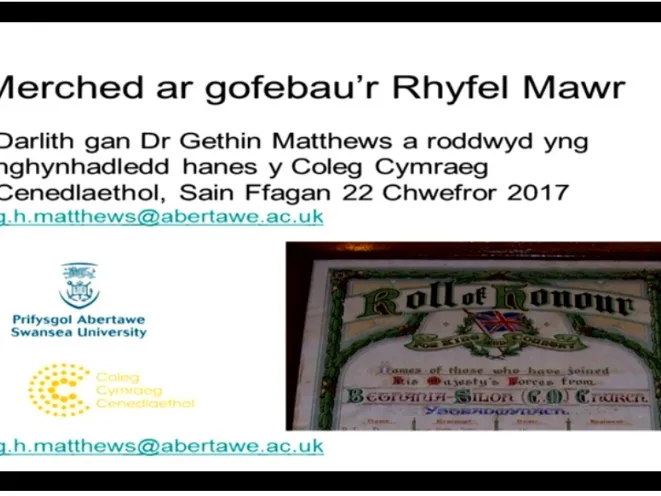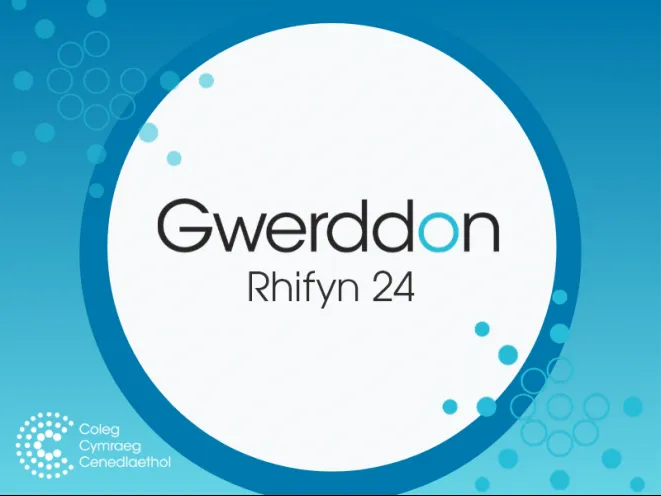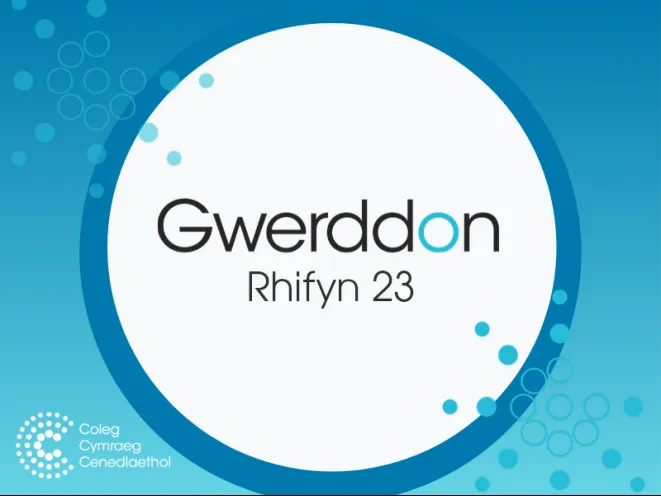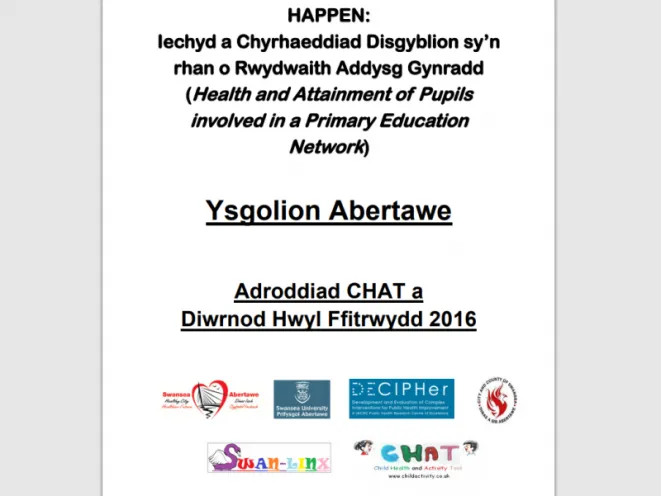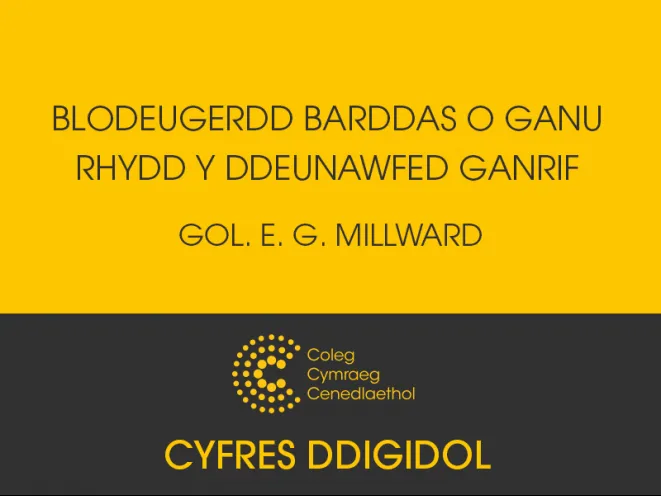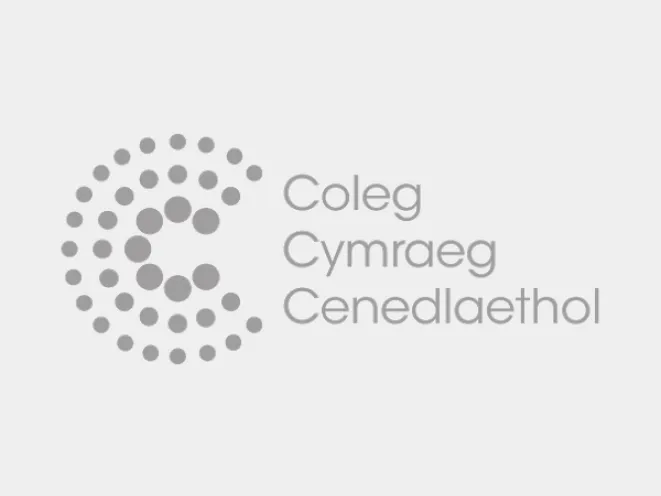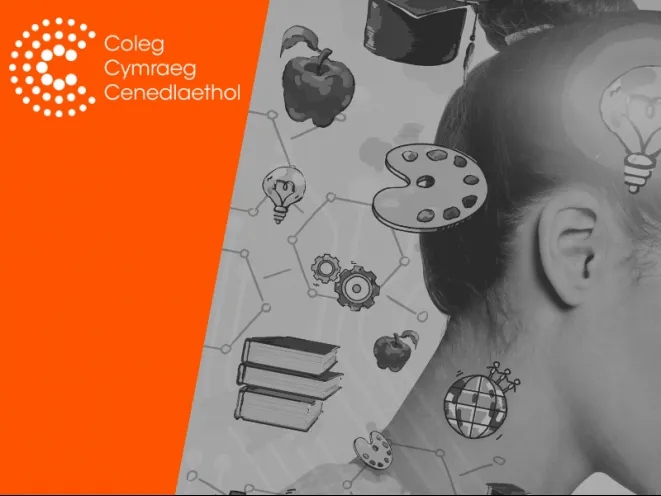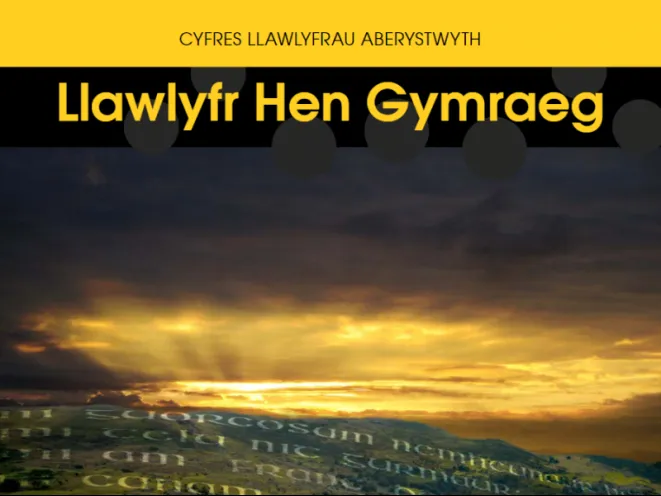Darlith gan Dr Gethin Matthews a roddwyd yng nghynhadledd hanes y Coleg Cymraeg Cenedlaethol, Sain Ffagan, 22 Chwefror 2017. Yn y ddarlith hon mae Dr Gethin Matthews yn edrych ar sut mae nifer fawr o ferched Cymru yn cael eu coffáu ar gofebau i'r Rhyfel Byd Cyntaf. Mae'n ystyried sut roedd eu cyfraniad yn cael ei gydnabod yn ystod y blynyddoedd o ymladd, a sut cafodd eu henwau eu cynnwys ar nifer sylweddol o gofebau a grëwyd ar ôl y Rhyfel. Mae'r cyfan yn ddealladwy mewn oes lle roedd 'Iaith 1914' yn rhemp, a grwpiau amrywiol yn cystadlu i ddangos eu teilyngdod a'u teyrngarwch: fodd bynnag, cyn bo hir fe gafodd cyfraniad merched ei anghofio a'i anwybyddu.
Merched ar gofebau'r Rhyfel Mawr
This leaf: the nature, origins and purposes of leaf colours
The state of the environment and the passage of time are reflected in the changing colours of the plants around us. Chlorophyll, the green pigment of leaves, captures the energy of sunlight that drives photosynthesis and powers the biosphere. The disappearance of chlorophyll from autumn leaves reveals the yellows and oranges of another family of plant pigments, the carotenoids. Carotenoids protect plants from stresses and are also responsible for the colours of many flowers and fruits. In autumn, the leaves of species such as maples make red and purple anthocyanins, which are members of a diverse family of pigments and defence chemicals. Plants use pigments to send signals to pollinators, dispersers and predators, among which are humans, who have a special physiological and psychological responsiveness to the plant chemistry that colours our world.
Music for the Memory: The effects of the Singing for the Brain project on memory and the quality of life of pe...
The purpose of this article is to determine the benefits of singing in a group on people who have dementia, specifically through the ‘Singing for the Brain’ sessions held in North Wales during 2012–13 by the Alzheimer’s Association. Previous research of group singing in the field of music and dementia will be discussed as well as looking at how ‘Singing for the Brain’ first started in Britain. The article will then focus on the fieldwork that was undertaken, presenting conclusions, and finally dealing with and evaluating these conclusions.
The Star in the Cross: the effect of the early imperial laws of Rome on the relationship between the Church an...
The relationship between the Roman Catholic Church and the Jews has always been difficult, and this article explores the way in which the early imperial laws of Rome influenced that relationship. Having discussed a selection of laws, consideration is given to how they affected the social standing of the Jews in a growingly Christianised world. There is also a discussion of how a few of the early anti-Jewish laws seemed to be reintroduced during the Middle Ages, as well as during the horrific event which proved to be fateful to the Jewish-Christian relationship, the Holocaust. The article concludes by examining the significance of those imperial laws and questions the relationship of the Church and the Jews in the twenty-first century.
Ancient gentry and the modern nation: Gwaed yr Uchelwyr read in the light of anglophone Welsh fiction of the C...
The core argument of the essay is that it would be worth setting Saunders Lewis’ important early play, Gwaed yr Uchelwyr, in the context of several anglophone Welsh novels published at the turn of the nineteenth century that sought to assess the relevance of the culture of the indigenous gentry of Wales to the new nation celebrated by the Cymru Fydd movement. It is argued that familiarity with these texts could assist us to grasp the subtlety and rich ambivalence of the play’s ideological stance.
Adroddiad Swan-Linx Cymru ar iechyd a lles plant ysgol
Dyma adroddiad sy'n deillio o waith Prifysgol Abertawe ar brosiect Swan-Linx, prosiect iechyd a ffitrwydd sydd â'r nod o ymchwilio i iechyd a lles plant ysgol ym mlynyddoedd 5 a 6 (9-11 oed). Mae'r adroddiad yn seiliedig ar ddata a gasglwyd drwy gyfrwng: Arolwg iechyd ar y we o'r enw CHAT (Child Health and Activity Tool) sy'n gofyn cwestiynau am ymddygiadau iechyd gwahanol gan gynnwys diet, gweithgaredd corfforol, cwsg a lles. Diwrnod Hwyl Ffitrwydd, lle cafodd BMI (Mynegai Màs y Corff), ffitrwydd aerobig, cyflymder, cryfder, ystwythder, p?er, a hyblygrwydd yn cael eu mesur. Ariannwyd y gwaith cyfrwng Cymraeg gyda chymorth grant bach gan y Coleg Cymraeg Cenedlaethol.
Geiriadur Prifysgol Cymru
Mae ap Geiriadur Prifysgol Cymru yn cynnwys holl ddata Geiriadur Prifysgol Cymru, geiriadur Cymraeg cynhwysfawr tebyg i’r Oxford English Dictionary. Yn wahanol i GPC Ar Lein (http://gpc.cymru), mae modd lawrlwytho holl gynnwys y Geiriadur i’ch dyfais fel nad oes angen cysylltiad â’r Rhyngrwyd i’w ddefnyddio. Diffinnir pob gair yn Gymraeg gyda chyfystyron Saesneg ac enghreifftiau o’i ddefnydd o bob cyfnod ynghyd â tharddiad (etymoleg) i bob gair. Rhoddir gwybodaeth ramadegol fel cenedl a ffurfiau lluosog enwau.
Blodeugerdd Barddas o Gerddi Rhydd y G18 – E. G. Millward (gol.)
Blodeugerdd o gerddi rhydd o'r ddeunawfed ganrif wedi eu cyflwyno mewn rhagymadrodd, eu dethol a'u golygu gan E. G. Millward. Ceir hefyd ymdriniaeth ar ddechrau'r gyfrol â'r tonau Cymreig gan Phillis Kinney. Mae'r cerddi yn y gyfrol hon, sy'n rhan o gyfres Cerddi'r Canrifoedd, Barddas, yn ddarlun o ganrif amrywiol a welodd greu emynau Pantycelyn yn ogystal â phenillion megis: 'Haws yw codi'r môr â llwy, A'i roi oll mewn plisgyn wy, Nag yw troi fy meddwl i, Anwylyd fach, oddi wrthyt ti.'
Welsh Language Construction Terminology
A list of standard bilingual terms for the construction sector. The terms are suitable for students studying on level 1, 2 and 3 courses. There are key terms for the following subjects available below: Bricklaying Carpentry Painting and decorating Plastering The original content was created by Sgiliaith.
Genres y Cywydd
A collection of selected 14 critical articles discussing various genres of the Cywyddwyr period, c.1350-c.1650, which were originally published in Dwned, the journal of medieval Welsh history and literature.
Symposiwm Gair am Gelf
Cyflwyniadau o Symposiwm Gair am Gelf, 21 Hydref 2013. Gwenllian y Beynon, cydlynydd y symposiwm, yn cyflwyno'r cyrsiau celf cyfrwng Cymraeg sydd ar gael. Yr artist Osi Rhys Osmond yn trafod pwysigrwydd yr iaith Gymraeg a chelfyddydau cyfrwng Cymraeg.
Llawlyfr Hen Gymraeg – Alexander Falileyev
Dyma'r disgrifiad cynhwysfawr cyntaf un o Hen Gymraeg (iaith y 9fed ganrif hyd ddechrau'r ddeuddegfed) i ymddangos yn yr iaith Gymraeg. Mae'n addasiad (gan yr awdur ei hunan) o Gramadeg Hen Gymraeg, Alexander Falileyev, a gyhoeddwyd yn Rwsieg yn 2002, ac yn Ffrangeg yn 2008. Yn ogystal â throsi'r gwaith i'r Gymraeg, mae Dr Falileyev wedi'i addasu ar gyfer cynulleidfa Gymraeg, ac wedi ymgorffori ffrwyth yr ymchwil diweddaraf ar y testunau hyn (peth ohono eto i'w gyhoeddi). Mae hyn yn golygu y bydd o ddiddordeb i ysgolheigion profiadol yn ogystal â myfyrwyr a lleygwyr. Mae'n cynnwys disgrifiadau manwl o'r testunau hysbys, gyda llyfryddiaeth lawn, penodau ar ffonoleg, gramadeg a chystrawen yr iaith, a detholiad o destunau golygedig gyda nodiadau cynhwysfawr a geirfa. Mae'r llyfr hwn yn rhoi cyfle, am y tro cyntaf, i'r Cymry ddod i adnabod rhai o'r enghreifftiau cynharaf hysbys o destunau yn eu hiaith. Mae Dr Falileyev, yn enedigol o St Petersburg, Rwsia, yn arbenigydd ar yr ieithoedd Celtaidd. Mae wedi cyhoeddi'n helaeth ar enwau lleoedd a phersonol Celtaidd o Ewrop yn yr hen gyfnod, ac ar iaith a llenyddiaeth Cymru'r Oesoedd Canol Golygydd y Gyfres: Dr Simon Rodway, Prifysgol Aberystwyth.

